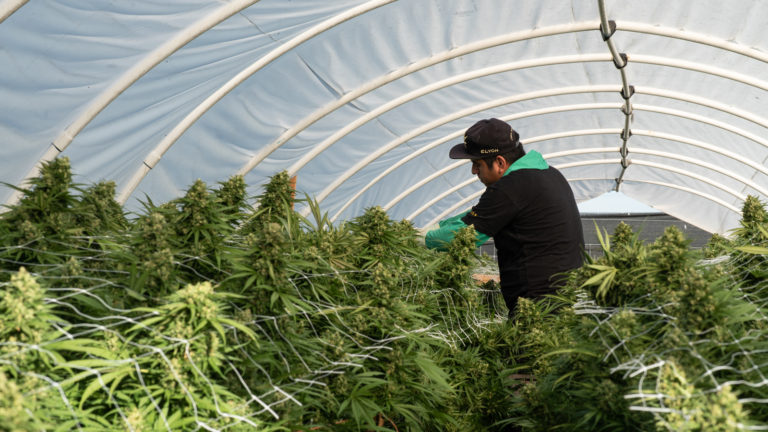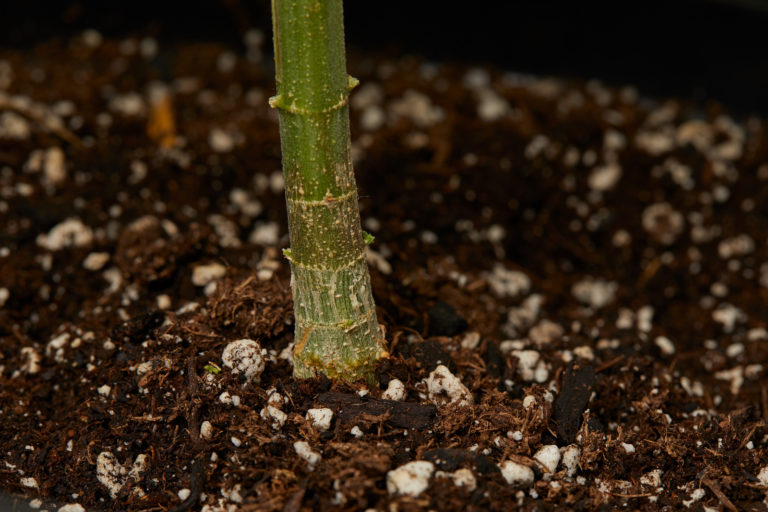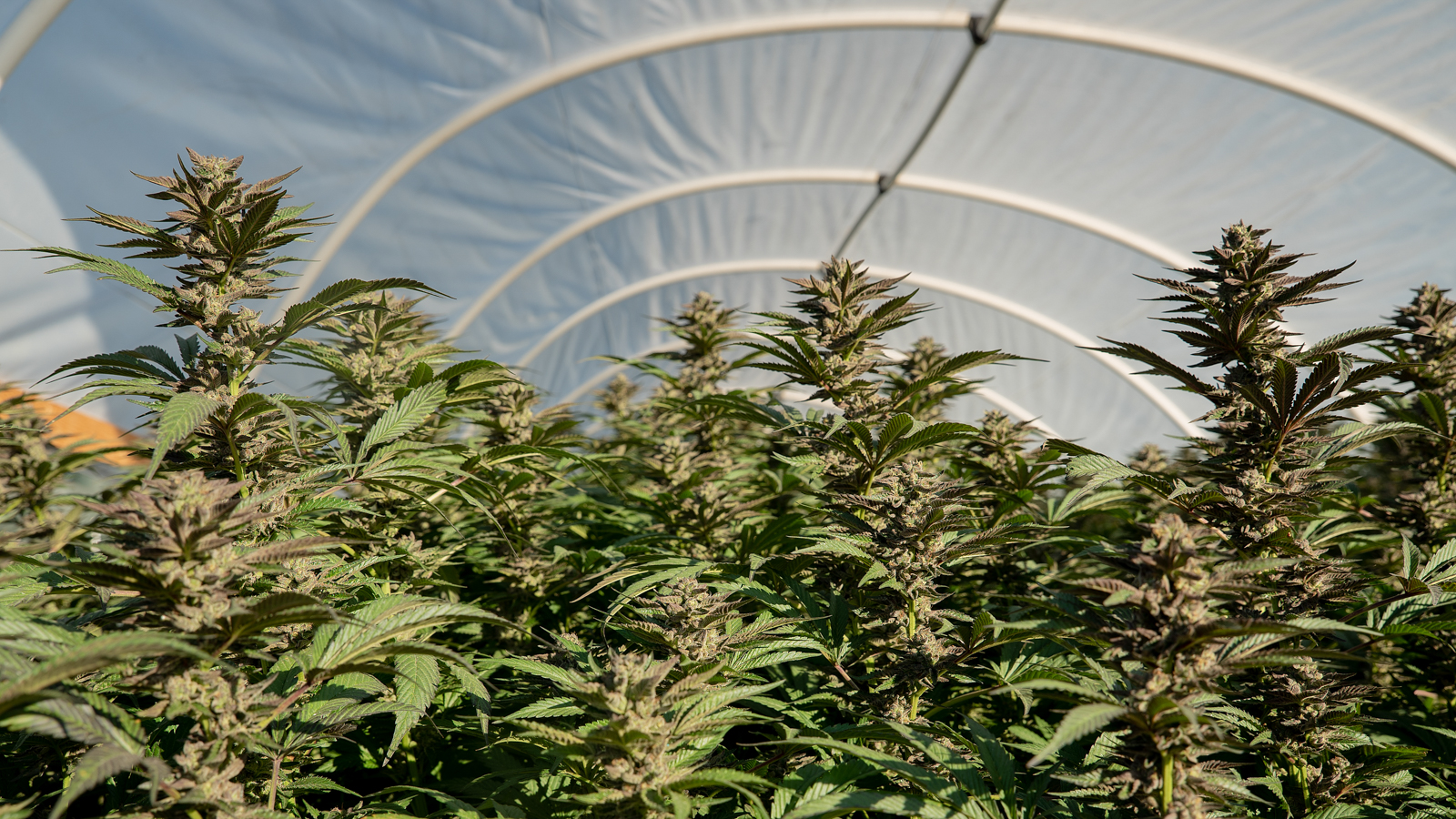Cannabis cultivation can take place indoors, outdoors, or in a combination of these two places: the greenhouse. A greenhouse can be as small as a tool shed or as large as an industrial building. If you have enough space to accommodate even a small greenhouse, this option may propel your cannabis cultivation to the next level.
In this guide, you'll learn why growing marijuana in a greenhouse can be effective and how to get started.
Benefits of growing marijuana plants in a greenhouse
The key word when it comes to growing cannabis in a greenhouse is control. Greenhouse cultivation provides the natural sunlight, fresh air, and other benefits of growing outdoors while eliminating the unpredictability of Mother Nature. Periods of rain and wind can wreak havoc on your weed garden, but a greenhouse protects plants from the elements. Likewise, pests, bacteria, and diseases are less likely to invade your plants in the shelter of a greenhouse.
 Photo by: Damien Robertson/Weedmaps
Photo by: Damien Robertson/WeedmapsImage lightbox

A marijuana greenhouse also puts you in control of two primary factors in successfully growing marijuana plants.
Lighting: A greenhouse gives cannabis plants the benefit of natural light without exposure to the harmful environmental stressors of outdoor grows. Using natural sunlight is energy efficient, so you can save money on electricity costs by not using artificial lighting.
Climate: In addition to protection from rain and wind, marijuana greenhouses can contain climate control equipment like dehumidifiers, exhaust fans, and heating and cooling systems. With the help of these tools, greenhouses can extend the growing season and allow for year-round cultivation.
Building a cannabis greenhouse
Whether you want to grow recreational weed or medical marijuana, the best greenhouse may be one that you build yourself. If you have the time and skills (or helpers) to construct your own greenhouse, this route will be the most cost-effective.
The ideal spot for your DIY grow room will be facing the sun. A slightly shaded area is fine, but make sure nothing is keeping the natural light from reaching your greenhouse. The more hours of light, the bigger the yield.
Think about the storage space you'll need for your greenhouse setup, including supplemental lighting and nutritional blends. You'll also need an easily accessible place to store water and soil, so that the greenhouse is a one-stop location for all your cannabis cultivation items.
When planning to build your own marijuana greenhouse, consider which material will create the ideal environment for happy plants. While glass is the traditional material, you can also use fiberglass or plastic. The latter two will be equally effective but not as fragile or expensive. Whichever material you choose, make sure you install proper ventilation to release trapped heat and let your plants breathe.
Whether it's a simple walk-in greenhouse or something more elaborate, check local laws to see if building permits or other formalities need attention before you start building.
Buying a cannabis greenhouse
If DIY is not your style, think about your budget and how many plants you'll want to grow then decide how much space you'll need for plants, climate control, and the rest of your greenhouse setup. Armed with that information, consider the options below.
Free-standing greenhouses: From a simple walk-in greenhouse with room for a couple of plants to the massive connected behemoths set up by commercial growers, free-standing greenhouses are what most people picture when they think of a greenhouse. They are apex shaped, like a house, and consist of metal or wood frames and glass, fiberglass, or plastic panels. Many have roof and/or side panels that open to allow for ventilation. This may be the most expensive option, but it also has the most room for plants while still allowing for location flexibility so growers can move it to best capture the sunlight. Inexpensive free-standing models start at less than $100 but they may not be very durable. Sturdier models cost closer to $1,000 and prices go up from there.
Attached greenhouses: These are usually shaped like a house and attached to the existing wall of a house, garage, shed, or barn. This greenhouse option is made of metal or wood framing with glass, fiberglass, or plastic panels. While they might be slightly less expensive than free-standing greenhouses because one wall is already built, the location of attached models is dictated by the location of the existing structure. Prices vary greatly depending on location, size, and construction materials.
Polytunnel: These elongated, dome-topped greenhouses have an aluminum frame and a covering of polythene. They are usually big enough to walk into but not as sturdy as actual greenhouses. Accordingly, polytunnels are on the lower end of the price range, starting at around $160. These can be durable but do need some maintenance, especially replacement of the cover every three to five years.
Cold frames: Cold frames are another affordable choice, though they are small and temporary. While it's possible to construct a cold frame yourself, you can purchase a solid one for between $80 and $200, depending on the size. Cold frames are generally small boxes that sit on the ground. They are constructed out of wood or plastic frames with plastic or glass panels. Cold frames are normally used as is, with only heat from the sun, especially in warm, dry climates like Southern California. In areas with colder temperatures, consider installing a heating system, also known as a hotbed.
Size and panel opacity: Aside from type and material, two other greenhouse considerations are size and panel opacity. When deciding on size, think about what strains you might want to grow and how tall they might get. A good general rule of thumb is to get a larger greenhouse than the one you think you'll need. If you don't need the extra room for equipment and maneuverability, you can always add more plants. As for panel opacity, clear might seem like the best choices but the sun beating down on your cannabis plants can lead to competition in young plants and hot spots later. Diffuse or semi-diffuse panels provide ample, even light, preventing hot spots, competition, and uneven growth. All that should equal better yields.
Growing marijuana in a greenhouse
Once you have the best greenhouse for you, it's time to put your cannabis cultivation skills to the test. Here are the most important aspects of growing top-quality weed in a greenhouse.
Soil: First and foremost, invest in top-quality soil as this will impact the entire growing process. Pick a nutrient-packed soil that contains organic substances like compost and worm castings. Pay attention to the pH levels of the soil as well — aim for a range of 5.8 to 6.3. Other qualities to look for in soil include good drainage ability, high oxygen levels, and effective water retention. You could also make your own super soil.
 Photo by: Gina Coleman/Weedmaps
Photo by: Gina Coleman/WeedmapsImage lightbox

Equipment: From irrigation to climate-control systems to exhaust fans, the supply list for a cannabis greenhouse can be long. But once you make an initial investment, most equipment will last season to season. Down the road, don't be afraid to add things like heating or lighting if your cannabis plants seem to need it.
Knowledge: The most high-tech equipment won't matter unless you have a thorough foundation in how to grow cannabis. This means understanding when seeds should be sown (generally April), when flowering occurs (eight to 12 weeks typically), and which cannabis strains do best in greenhouses (autoflowering strains such as Purple Punch Auto, Jack Herer, and 8-Ball Kush enjoy a great reputation among cannabis growers).
Should I grow weed in a greenhouse?
When considering greenhouse cultivation, think about how much control you would like to have over your crops. If reliable conditions make growing cannabis a more enjoyable experience for you, then a greenhouse may be the way to go. Also, assess how much elbow grease you want to put into the growing process and if you want to build a structure from the ground up. Finally, evaluate your budget and cultivation goals before you make the decision to grow marijuana in a greenhouse. Whether you choose to grow weed outdoors, indoors, or in a greenhouse, raising plants from seed to harvest can be a rewarding experience.

